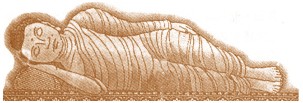Lying Down To Rest In The Way Of A Lion King,
Not The Way Of Hungry Ghosts or Astral Beings.

◆ China Times, Formosa January 4, 1997
◎Authors: Dr. Guo Zheng Dian, Aspiratory Therapy Department, Taipei Veterans General Hospital, and Dr. Chen Gao Yang, Medical Department of Tao Yuan Provincial Hospital.
In 1957, Lee Tsung Dao and Yang Chen Ning became laureates of the Nobel Award in physics because they discovered that the law of conservation of parity did not hold true for weak nuclear reactions. From Buddhist scriptures, we know that as early as 2500 years ago, Shakyamuni Buddha discovered the lack of parity between right and left when humans lie down. Unfortunately the Nobel Prize has never been awarded to a deceased person, yet Shakyamuni Buddha's discovery deserves a Nobel Prize in Biological Medicine.
By analyzing the variation of heartbeats, our research proved that the Buddhist way of sleeping like a lion king -- inclining to the right with overlapping legs, is capable of increasing the activity of the parasympathetic nerves. This is the best posture for taking a relaxed rest, and is highly recommended to busy modern people who need a good rest but who suffer from insomnia. We also found that, among three lying postures, the recumbent position induces the highest rate of activity of the sympathetic nerves, and therefore makes it hard to stabilize the body and mind.
If a person doesn't have a good sleep, he will be bad tempered and likely to be in conflict with others. This is why the Buddhist scriptures say that the supine position is the astral sleeping posture.
In many medical
columns, Mr. Qiu Hong Hsiang has introduced a meditation method for
lying down. We think this method is based on the lying king's posture
of Buddhism. Here we cited the relevant parts from the scriptures for
your reference....: Three Thousand Codes of Manners for Senior Bhiksus;
Chapter 20 of the Madhyamagama Treatise, the chapter of the King of
Longevity, number 12 scripture for the Sleeping of Most Reverend
Seniors
(the second chanting of Siao Tu Cheng); the Dirghagama Treatise; the
Senior Rules for Monks and Nuns, Chapter 35....
|
|